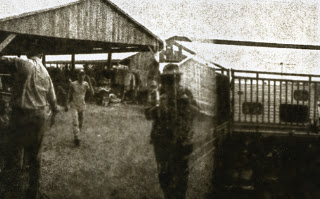To reinvent my photographs from Greece, I decided to project them in the classroom that I often teach in, and photograph the projections with a pinhole camera. I enjoy the idea of changing scale from a gigantic structure to a tiny digital sensor, to a wall sized projection, and then back to a film sized image.
My main pinhole camera is a 6 x 6 square format zero-image. It was given to me years ago by phenomenal photographer Elisha Ornes (who I am sure will be having those New York shows anytime now) and it is a trusty and lovely little camera. For my upcoming project, I decided to go with a different camera for a couple of reasons.
The first consideration is focal length. I have decided to photograph projections and it will be necessary to have the camera at a distance from the projection in order to keep its shadow from blocking the light. The zero-image pinhole is very close to the film plane and has the effect of a very wide-angle lens, making projection photography a difficult situation. It is wonderful for creating an exaggerated sense of space, such as in the image below, but would have to be located entirely too close to my subject to capture it in the way I envision.
The second camera consideration is aspect ratio. The original images that I am planning on reproducing are rectangular and I shy away from cropping to change shapes. The rectangular shape that we are accustomed to seeing in landscape photography can be traced back to ancient Greek mathematics, which could have possibly been applied to some of the structures that I photographed when they were originally built. A 35mm photograph has a 1 to 1.5 length to width ratio and many digital cameras copied that format. The Greek "Golden Mean" was approximately 1 to 1.6, which is close.
One camera in my collection is a Mamiya Universal that happens to have the film ratio that I desire (its a 6 x 9.) A feature that I love about Mamiyas is that with many models, the lens elements are removable! This is a wonderful feature for cleaning and also ideal for pinhole conversion because you can still use the cameras own shutter on a bulb setting. To remove the elements, I made a crude tool with some tin snips and some scrap metal, which worked fine. I was able to remove another lens element using a coincidentally perfect sized putty knife.
I made my pinhole with a needle and a piece of a thin pie tin, attached to a round piece of mat board and fleshed out with electrical tape to fit snug in the lens hole. I then had a 6 x 9 pinhole camera that could be operated with a cable release and featured a removable back with a darkslide. With the focusing ring racked all the way forward, I had plenty of distance to move the camera farther back and still fill up my picture plane with my projection.
I am curios to see how these photographs will relate to the originals. Will they simply be copies, or will they emerge as unique?
The postcards are finished for the Postcard Collective project. Now for
the task of addresses and mailing. The paper negative printing process
did change the appearance of the image, and sepia toning the RC paper
created many unique prints, each one different.
Warm thoughts to you and yours and thanks for allowing me to share.
http://www.youtube.com/watch?v=lgbKW8-rgO4






No comments:
Post a Comment